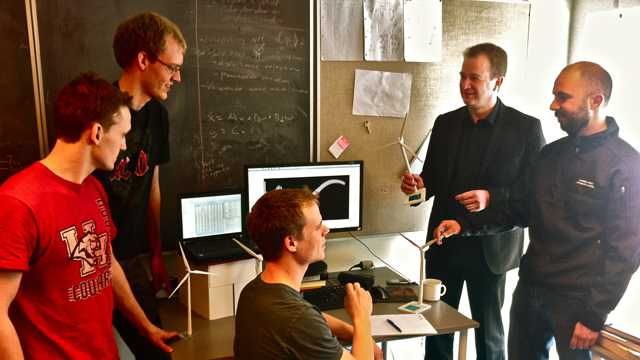Aalborg University Pioneers Problem-Based Learning
“Our project-organized, problem-based learning model benefits immensely from a high-level programming and simulation platform. MathWorks tools enable students to concentrate on what is important: learning to apply new concepts and working with industry partners to develop real solutions.”
Challenge
Solution
Results
- Multidisciplinary projects simplified
- Collaboration with industry partners streamlined
- Tight project deadlines met

Problem-based learning (PBL) replaces subject-based instruction with group work in which students collaborate to solve real-world problems. The PBL program at Aalborg University (AAU) in Denmark, founded more than 20 years ago, has become a model for universities around the world.
From their very first semester, AAU students use MathWorks tools and Model-Based Design to work on actual industry problems. “With MATLAB and Simulink, the distance between the theory and the implementation is very small,” says Professor Jakob Stoustrup, Ph.D., of the Aalborg University Department of Electronic Systems – Automation and Control. “The high-level programming interface and simulation environment enable students to complete meaningful projects and collaborate with our industry partners.”
Anette Kolmos, Chairholder for UNESCO Chair in PBL in Engineering Education at AAU, adds, “Students gain a deeper understanding of theory and concepts when they apply them to actual problems. Model-Based Design with MATLAB and Simulink is an effective way of enabling PBL that prepares students for real, multidisciplinary engineering work in industry.”
Challenge
Students typically complete a three-year bachelor’s program followed by a two-year master’s program. Ensuring that the students finish 10 projects in 10 semesters is the faculty’s principal objective. “We need students to come up to speed quickly on each project and focus on the solution,” says Dr. Stoustrup. “If C code is needed, then we prefer the students to generate it from a model instead of getting bogged down in hand coding.”
Because having a common development platform dramatically improved workflow when students collaborated on previous projects across engineering departments or with private companies, AAU wanted to enable all students to access an industry-standard set of tools.
“Many of our projects involve precommercial prototyping. Our partners often provide basic models of their systems, and the students frequently deliver a control model for simulations,” notes Dr. Stoustrup. “To make the process more efficient, we need to use the same tools as our partners.”
Solution
Aalborg University acquired a Campus-Wide License for MathWorks products, giving students and faculty both campus-wide and laptop access to MATLAB®, Simulink®, and dozens of companion toolboxes.
Each semester, students spend about 50% of their time in traditional course activities and the remaining 50% on projects. MathWorks tools are integrated throughout the curriculum. Dr. Stoustrup, for instance, teaches a third-year course on modern control theory in which students use MATLAB and Control System Toolbox™ to model systems, build state-space models, design controllers, and run simulations to verify their algorithms. In the postgraduate Robust Control course, students use MATLAB, Control System Toolbox, and Robust Control Toolbox™ to simulate dynamic multivariable systems with uncertainty models and develop H∞ control solutions.
Student projects vary and include renewable energy, marine boilers, and satellites. Within renewable energy, AAU works closely with several wind turbine companies on control systems for wind turbines and wind farms. AAU students are also working on the European AEOLUS project, using MATLAB and Simulink to model, simulate, and prototype control systems and condition monitoring algorithms for wind farms.
Most projects involve simulating, benchmarking, or prototyping potential solutions. In some cases, the solutions are refined and deployed by the sponsoring company. A manufacturer of marine boilers used Simulink Coder™ to generate production code from the control model that students developed in MATLAB and Simulink.
Automation and control students in the Department of Electronic Systems have completed several projects for the European Space Agency in which they used MATLAB, Simulink, and several toolboxes to model and simulate monitoring systems that detect faults during a spacecraft’s re-entry. They also designed, developed, and generated code to control the attitude of two microsatellites that have been put into orbit; a third is under development. Collaboration was enhanced because the various teams could share models.
Results
Multidisciplinary projects simplified. “With the Campus-Wide License, all faculty and students on campus have access to MATLAB, Simulink, and various toolboxes,” says Dr. Stoustrup. “On multidisciplinary projects, students with quite different educational backgrounds can work together more easily because they are using the same tools.”
Collaboration with industry partners streamlined. “Many of our industry partners use MATLAB and Simulink, which makes the PBL process more efficient,” says Dr. Stoustrup. “Companies often provide models that help students jumpstart their work, and students deliver models that our partners use for simulation or even code generation.”
Tight project deadlines met. “The students begin a new project each semester, and they need to be productive quickly to complete them on time,” notes Dr. Stoustrup. “With MATLAB and Simulink, students can move quickly from simple equations and theory to testing real implementations. They don’t have to reinvent the wheel because the toolboxes provide many of the advanced algorithms they require. Automatic code generation enables further time savings.”
Acknowledgements
Aalborg University provides campus-wide training through MATLAB Academic Online Training Suite. This portfolio of self-paced online courses covers a range of topics and is used to increase productivity, support multidisciplinary projects, and enhance student skills.